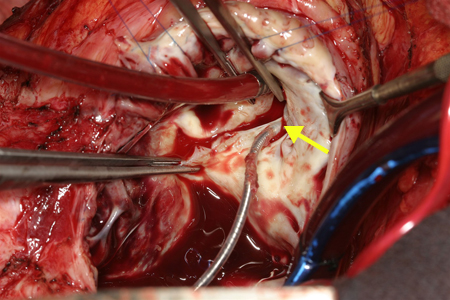Summary
Definition
History and exam
Key diagnostic factors
- fatigue and effort intolerance
- dyspnea
- palpitations
- jugular venous abnormality
- irregular heart rhythm
- parasternal systolic murmur
- increased systolic murmur on inspiration (Carvallo sign)
- peripheral edema
Other diagnostic factors
- abdominal distension
- early satiety, dyspepsia, or indigestion
- liver and systemic venous pulsation
Risk factors
- left-sided heart failure
- dilated tricuspid annulus
- rheumatic heart disease
- permanent pacemaker
- endocarditis
- carcinoid heart disease
- pacemaker lead entrapment
- ischemic cardiomyopathy
- constrictive pericarditis
- congenital heart disease
- toxins
- rheumatoid arthritis
- radiation therapy
- trauma
- Marfan syndrome
- tricuspid valve prolapse
Diagnostic tests
1st tests to order
- transthoracic or transesophageal echocardiogram
- ECG
- LFTs
- serum BUN and creatinine
- CBC
- CXR
Tests to consider
- operative transesophageal echocardiogram
- postoperative transthoracic echocardiogram
- cardiac catheterization
- cardiac MRI (preferred technique for evaluation of right ventricular size and function)
Treatment algorithm
primary: mild or moderate
primary: severe
secondary: mild or moderate
secondary: severe
Contributors
Authors
Shahab A. Akhter, MD
Professor of Cardiothoracic Surgery
Division of Cardiac Surgery
Department of Cardiovascular Sciences
Brody School of Medicine
East Carolina University
Greenville
NC
Disclosures
SAA declares that he has no competing interests.
Paul Tang, MD, PhD
Assistant Professor
Department of Cardiac Surgery
University of Michigan
Ann Arbor
MI
Disclosures
PT declares that he has no competing interests.
Jarred Mondonedo, MD, PhD
Cardiothoracic Surgery Fellow
Department of Cardiac Surgery
University of Michigan
Ann Arbor
MI
Disclosures
JM declares that he has no competing interests.
Acknowledgements
Dr Shahab A. Akhter and Dr Paul Tang would like to gratefully acknowledge Dr Kevin L. Greason, Dr Sorin V. Pislaru, and Prof. Thoraf M. Sundt III, previous contributors to this topic.
Disclosures
KLG, SVP, and TMS declare that they have no competing interests.
Peer reviewers
Larry A. Weinrauch, MD
Assistant Professor of Medicine
Harvard Medical School
Watertown
MA
Disclosures
LAW declares that he has no competing interests.
Prakash P. Punjabi, MB BS
Consultant Cardiothoracic Surgeon
Imperial College Healthcare NHS Trust
London
UK
Disclosures
PPP declares that he has no competing interests.
References
Key articles
Shah PM, Raney AA. Tricuspid valve disease. Curr Probl Cardiol. 2008 Feb;33(2):47-84. Abstract
Vahanian A, Beyersdorf F, Praz F, et al; ESC/EACTS Scientific Document Group; ESC Scientific Document Group. 2021 ESC/EACTS Guidelines for the management of valvular heart disease. Eur Heart J. 28 Aug 2021 [Epub ahead of print].Full text Abstract
Lancellotti P, Moura L, Pierard LA, et al. European Association of Echocardiography recommendations for the assessment of valvular regurgitation. Part 2: mitral and tricuspid regurgitation (native valve disease). Eur J Echocardiogr. 2010 May;11(4):307-32.Full text Abstract
Writing Committee Members., Otto CM, Nishimura RA, et al. 2020 ACC/AHA Guideline for the Management of Patients With Valvular Heart Disease: A Report of the American College of Cardiology/American Heart Association Joint Committee on Clinical Practice Guidelines. J Am Coll Cardiol. 2021 Feb 2;77(4):e25-e197.Full text Abstract
Abbas M, Hamilton M, Yahya M, et al. Pulsating varicose veins!! The diagnosis lies in the heart. ANZ J Surg. 2006 Apr;76(4):264-6. Abstract
Reference articles
A full list of sources referenced in this topic is available to users with access to all of BMJ Best Practice.

Guidelines
- 2022 AHA/ACC/HFSA guideline for the management of heart failure
- 2020 ACC/AHA guideline for the management of patients with valvular heart disease
More GuidelinesVideos
Tricuspid regurgitation
More videosLog in or subscribe to access all of BMJ Best Practice
Use of this content is subject to our disclaimer